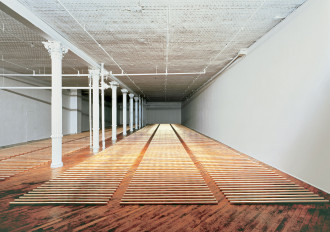Walter De Maria
May 7, 2016–January 12, 2019, Dia Beacon
Overview
In the early 1960s Walter De Maria began tracing “invisible drawings,” which consisted of graphite lines rendered so lightly that they operated at what he described as the “the threshold of visibility.” De Maria argued that these drawings had the effect of doubling the viewer’s senses, throwing into question the categories of what is seen and what is known. De Maria had an abiding interest in exploring the limits of perception, and this tension between apprehension and comprehension offers a rubric for understanding the artist's formally Minimal and Conceptual practice.
De Maria subversively deployed linear systems of measurement throughout the 1970s. The Broken Kilometer (1979), for example, consists of five rows of one hundred two-meter-long rods. When placed end-to-end they measure precisely one kilometer. Installed as a permanent Dia site at 393 Broadway in New York , the rods appear to be spaced evenly along the floor, however, the distance between rods increases by five millimeters with each rod. This serial composition results in a paradoxical effect that renders metric distance visually obsolete through its very physical presence.
In another large-scale installation, The Lightning Field (1977), also commissioned and maintained by Dia, four hundred polished steel rods are planted in the high desert of New Mexico. Arranged in a grid that is one mile by one kilometer, De Maria juxtaposes the metric and imperial systems against each other and the seemingly endless void of the desert landscape. The result brings into focus the dissonant play between the relative and the absolute.
Artist
Walter De Maria
Walter De Maria was born in Albany, California, in 1935. He died in Los Angeles in 2013.
Books
Artists on Walter De Maria
Artists on Walter De Maria is the second installment in a series culled from Dia Art Foundation’s Artists on Artists lectures, focused on the work of artist Walter De Maria. It features contributions from Richard Aldrich, Jeanne Dunning, Guillermo Faivovich and Nicolás Goldberg, and Terry Winters.
Works at Other Sites

Walter De Maria, The Broken Kilometer

Walter De Maria, The Lightning Field

Walter De Maria, The New York Earth Room

Walter De Maria, The Vertical Earth Kilometer
Explore
Jane McFadden on Walter De Maria
Move to Jane McFadden on Walter De Maria pageRichard Aldrich on Walter De Maria
Move to Richard Aldrich on Walter De Maria pageTerry Winters on Walter De Maria's The Lightning Field
Move to Terry Winters on Walter De Maria's The Lightning Field page
Jane McFadden on Walter De Maria
Move to Jane McFadden on Walter De Maria page
Precious Okoyomon with Gio Escobar on Walter De Maria
Move to Precious Okoyomon with Gio Escobar on Walter De Maria pagePrecious Okoyomon with Gio Escobar on Walter De Maria
Move to Precious Okoyomon with Gio Escobar on Walter De Maria pageFaivovich & Goldberg on Walter De Maria
Move to Faivovich & Goldberg on Walter De Maria pageJeanne Dunning on Walter De Maria and Robert Smithson
Move to Jeanne Dunning on Walter De Maria and Robert Smithson pageBrett Littman on Walter De Maria
Move to Brett Littman on Walter De Maria pageLars Nittve and Jessica Morgan on Walter De Maria
Move to Lars Nittve and Jessica Morgan on Walter De Maria page
Jane McFadden on Walter De Maria
Move to Jane McFadden on Walter De Maria page
Precious Okoyomon with Gio Escobar on Walter De Maria
Move to Precious Okoyomon with Gio Escobar on Walter De Maria pagePrecious Okoyomon with Gio Escobar on Walter De Maria
Move to Precious Okoyomon with Gio Escobar on Walter De Maria page
Lars Nittve and Jessica Morgan on Walter De Maria
Move to Lars Nittve and Jessica Morgan on Walter De Maria page



